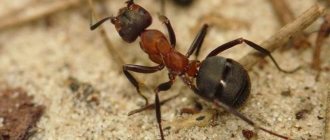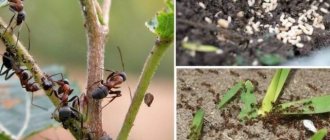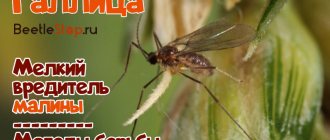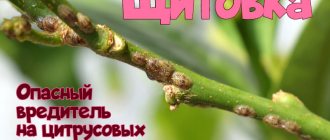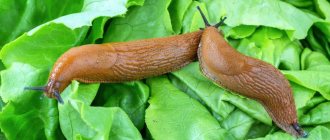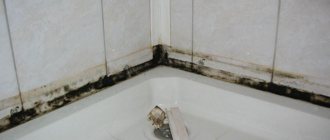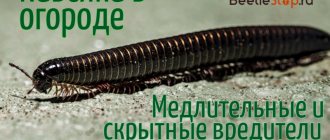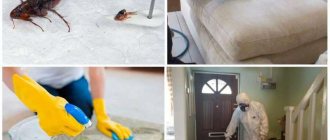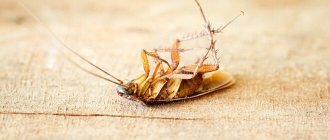Ants are one of the most common beneficial hymenopteran insects. However, their excessive quantity in the garden or vegetable garden can cause great damage to the future harvest. The fact is that garden ants prefer to build their nests in the roots of seedlings, gnawing them. Insects can be found especially often in strawberries and currants, as well as under plum, apple or pear trees. They often harm bell pepper, eggplant or cabbage seedlings by digging long tunnels in the ground. You will learn what to do if ants eat cabbage in this article.
What to do for prevention before and after sowing?
Preventative measures will be the best remedy for problems when growing vegetable crops. It is easier to prevent the appearance of ants than to destroy them. Experienced gardeners recommend the following preventive measures:
- In early spring, carefully dig up the soil, this will reduce the number of eggs laid.
- When planting seedlings, intervals must be observed so that as the plants grow, they do not shade the row spacing. In dense areas, pests spread with particular speed. It is necessary to weed out weeds in a timely manner, do not leave them between the beds, take them to the compost heap or bury them. Numerous insects can live under weeds.
- In the summer, after watering the garden, you need to loosen the soil frequently and deeply, throwing out old roots and hummocks. Parasites love to hide in them.
- Damp and shaded areas in the garden and vegetable garden must be drained.
Preventive measures can significantly reduce the number of cabbage pests, but they can only be finally dealt with by involving hosts from neighboring areas.
Ants in the garden plot and vegetable garden contribute to the breeding of pests. When their colony grows to large sizes, it becomes a huge problem. It is difficult, but possible, to remove uninvited small guests. Using folk, mechanical, and chemical methods, there is a chance to get rid of them. In the future, it is imperative to take preventive measures, since insects will be attracted to sweet odors to the area.
Description of the insect
The black garden ant (lasia) is common in many countries. This species is most often found in central Russia, and can even settle in city houses.
Habitat
The garden ant does not build the usual tall houses . It builds its nest in the soil, going down to 1 meter. A small mound may form near the entrance. Insects are capable of living in rotten wood of old stumps, in hollows, under bark, stones, and piles of mown grass.
Pests love sweet food, so they are able to make numerous tunnels in weakened old fruit trees. Many of them settle at the roots of seedlings, in strawberries and currants. They need loose soil, that is, a summer cottage and vegetable garden are excellent for life.
Attention!
Insects have good adaptability, the secret of which lies in high fertility, long life of the family, and the peculiarities of its formation.
Appearance
The color of the ant is black or dark brown . The shade depends on the color of the soil where the species lives. There are many short hairs on the body. Length from 3 to 11 mm. Largest in size, the uterus lives up to 28 years. Males live for about a year.
Danger to the plant
Garden ants love all varieties of cabbage. They prefer the soft, first leaves of seedlings. It's good to extract juice from them. Cauliflower, broccoli, and Brussels sprouts have tender leaves in the first stages of growth. Pests feast on the juice, but the entire plant dies.
At what time of year do they usually eat the crop?
Garden ants themselves , when the seedlings have just been planted in the ground. Once the plant has grown, it is already difficult for small insects to cope with it. But they can contribute to the spread of aphids on cabbage leaves. This will continue throughout the summer.
We permanently get rid of ants
Every gardener knows what damage and harm garden ants cause to the garden. Naturally, you need to get rid of them as soon as possible.
In order to effectively destroy ants, you need to know which species has settled in the garden.
Black garden ants
These ants are considered real pests of the garden and garden. They can build their house right at the root of a tree or bush. The favorite food of ants is the secretions of aphids, with which the ants are in a kind of symbiosis: aphids also harm plants, and ants protect them from ladybugs and other insects.
Where a cluster of aphids appears, protective ants will no doubt appear. Therefore, it is imperative to get rid of aphids at the same time as ants.
Red pharaoh ants
The settlement of red ants on the site is a natural disaster for plants. This species is able to quickly restore its numbers, adapt to chemicals, and even get into the house. They can even destroy a tree by settling in its roots. Nothing grows near the ant's earthen house. They, like black ones, feed on aphid secretions.
How to deal with ants?
The fight needs to start comprehensively. The favorite place for insects to settle is in places that are practically not subject to mechanical treatment. Therefore, you need to dig up the soil in the garden as often as possible, thereby disturbing the ant's peace and destroying it from the nest.
Taking the necessary measures for successful destruction:
- destroy the anthill;
- comprehensively protect garden plants;
- do not allow the ant colony to grow;
- create conditions for causing damage to the colony;
- destroy the ants' nurse - aphids.
To protect trees, their trunks and the ground around them should be whitened with a strong solution of lime. An ant nest that appears on a site must be immediately destroyed, dug deep, filled with lime solution, covered with ash and dug again.
This will give the insects a reason to go elsewhere. It doesn't hurt to be vigilant here; you need to keep an eye on it. so that they do not move to another place in the garden.
What do you need to get rid of ants in your garden?
To get rid of harmful insects forever, you need to destroy the aphids and the queen ant - the queen. In the absence of quality food, the ants will go where it is.
You can fight garden ants with:
- mechanical method, to influence insects with physical effects in a lethal dose - heat and cold, acid and alkali;
- biological - use ant enemies;
- biochemical, using poisonous plant decoctions and tinctures;
- agrotechnical, contributing to the creation of unfavorable living conditions;
- agrochemical, using chemicals;
- preventive, which prevents the settlement of insects.
Various chemicals, which include the chemical compound diazinon, which causes paralysis of the insect and has a damaging effect on its nervous system, also help to completely get rid of ants. Within two days, all individuals that came into contact with the drug die.
To destroy about 200 anthills, only 10 ml of product is enough. The drug is capable of destroying both adult individuals and their larvae, and the treated soil repels new insects from settling.
If you plant valerian and mint near the beds, it is unlikely that ants will settle in these places. Also, to get rid of insects, soda, ash, and boric acid are used, which are used to fill and fill ant heaps.
A mixture of oregano and sulfur, a solution of kerosene, sunflower oil and water has a striking effect on insects. The ant nest can be dug up and poured with boiling water, which will help destroy the queen.
In the old days, ants were gotten rid of using effective methods that have survived to this day. They cut strips from sheepskin, soaked them in carbolic acid and wrapped them around raspberry shoots 15 cm from the ground.
Finely chopped onion and garlic, a decoction of tomato tops poured into an anthill drives away ants. Traps in the form of jars of sweet water were famous for insects. The insects climbed into the jar and simply drowned in the liquid. The syrup was also poured into the anthill through tubes, and the insects walking along the sweet path were crushed.
Review of effective drugs
If using treatment at home with folk remedies can mainly only achieve the expulsion of aphids from cabbage beds, then through the use of professional purchased preparations people achieve their complete extermination. To achieve even better results, it is recommended to alternate chemical agents.
Fitoverm
Among biological products, Fitoverm should be especially noted. With its help, they successfully fight against various parasitic insects.
A solution is used against aphids on cabbage, which is obtained from a liquid concentrate of this substance and water in a ratio of 4:1000. For each hundred square meters, 400 ml of working solution is used.
Spark
An insecticide such as Iskra has long gained popularity among gardeners due to its high efficiency. It can be purchased at retail outlets in the form of a liquid concentrate, tablets or powder.
On the day of spraying, prepare the solution according to the instructions. The protective effect lasts about 20 days. During this period, adult insects and caterpillars of any age die.
Tanrek
This insecticide belongs to the group of enteric contact agents. Once on the integumentary membrane or in the intestinal tract of the insect, the chemical blocks nerve impulses, causing rapid death. Tanrek's water-soluble concentrate is available in the form of ampoules, bottles or canisters.
To kill aphids on cabbage by spraying, dissolve 5 ml of the chemical in 10 liters of water.
Aktara
This is a fairly new liquid insecticide, but has already proven itself. Against aphids, this is one of the most popular remedies, and one treatment is almost always enough to exterminate the parasite. The product penetrates the plant tissue 2 hours after treatment. Together with the juice, the poison enters the insect's body, causing paralysis and inevitable death.
In order to kill aphids, it is enough to dilute 2 g of the drug in 10 liters of water. The work is carried out by spraying.
Deltamethrin
It is classified as a broad-spectrum insecticide. After its use, aphids, fleas, and caterpillars of various butterflies die from paralysis. Due to the content of only natural components, it is absolutely harmless to animals and humans.
The effect of the chemical begins immediately and lasts for 3 weeks.
Pyrethrum
This is a preparation of biological properties, the action of which is based on a special compound isolated from chamomile. The product is harmless to culture and warm-blooded creatures. It only kills aphids.
On the day of treatment, 60 g of pyrethrum are dissolved in 10 liters of water. Treatments can be carried out 2 times a month throughout the warm period of the year.
Karbofos
This chemical has been tested by time. Vegetable growers have been using it for a long time when cabbage and rapeseed are severely infested by aphids. An organophosphate insecticide effectively kills adult aphids and their larvae. During the summer, only 1 treatment of cabbage with Karbofos is carried out. Mass death of pests occurs after 2 hours, and the protective effect lasts up to 20 days.
Safes
This chemical product is not as toxic as Karbofos. It is often used on seedlings before planting them in garden beds. The solution must be prepared according to the instructions by dissolving 5 g of the chemical in 5 liters of water. The death of insects occurs within 3 days.
Rovikurt
It is produced industrially in the form of a dark liquid in canisters of various capacities. The drug shows excellent results against aphids and other pests on young cabbage plantings. Some gardeners treat the soil with it after sowing vegetables to prevent a complex of pests.
Karate
This drug shows good effectiveness against a large list of pests, including aphids on cabbage. Available in liquid form in sealed ampoules or in tablet form.
Corado
This is a very effective domestic insecticide used against aphids, various flea beetles, the Colorado potato beetle and other insects. The manufacturer packages Corado in ampoules of 1 ml, bottles of 10 and 25 ml. The product affects the nervous system of aphids, which ultimately leads to their death.
In the process of preparing the solution, 1 ml of the substance is dissolved in 1 liter of warm water. After mixing, add another 4 liters of raw water to the solution. Then they start spraying.
Cabbage whites
Already in early May you can see a white-winged butterfly with black spots on its wings fluttering merrily from plant to plant. But the vegetable grower is not too happy about such a beauty, because the voracious caterpillars of the cabbage butterfly can severely damage cabbage heads, often making them completely unfit for consumption. First, the caterpillars of the white butterfly eat the lower part of the leaves, and then move inside the head of cabbage, gnawing passages in it and leaving traces of their vital activity.
Protection:
The simplest means of control is to periodically inspect the leaves from the underside and manually collect caterpillars and egg clutches. Most pests can be destroyed by predatory insects and birds. Spraying with chemicals should be carried out only in large areas, where manual collection is impossible.
Another way to protect against cabbage whites is to cover the beds with agrofibre. The covering material reliably hides the cabbage from the butterfly's field of view and creates a microclimate that is very beneficial for plant growth.
Also, quite often, gardeners use a distracting maneuver for protection: they install low twigs between the cabbage plants, on which they put a white eggshell. This is a kind of signal for the white butterfly - there is already a competitor on the site!
Why are ants harmful in the garden?
Ants always appear where there is tasty, aromatic and sweet food. Home garden beds and summer cottages are no exception: fruit trees with sweet fruits, berries, seedlings of nightshades and other vegetable crops, in particular cabbage - all these plants are attacked by ants, which cause serious damage to the crop and spoil the roots of fruit trees.
In addition to sweet plants, ants are also attracted to the liquid (honeydew) that appears as a result of the activity of garden aphids. In turn, aphids feed on plant sap - as a result of eating by these insects, plants turn yellow, wither, lose leaves and eventually die. Therefore, the appearance of such a duet on the site should serve as a signal for taking urgent measures, since such unwanted guests can cause serious damage to the crop. In places where ants live, the acidity of the soil also changes, which negatively affects plant growth.
How to get rid of ants on cherries
The appearance of ants on a summer cottage causes a lot of trouble for summer residents. Often these small insects are not alone. Along with them, aphids also attack plants. To preserve the harvest and save crops from damage, you need to know how to get rid of ants on cherries
There are enough ways, it is important to choose the most effective one for yourself.
What are the ways to fight
To get rid of ants on cherries, you can choose from several methods:
- Application of insecticides. This is the fastest and most reliable way to destroy pests. Popular drugs include Aktara, Karbofos, Fufan or Confidor. The poison can be sold in the form of powders, sprays, and liquids. Experts recommend using systemic insecticides that last a long time in tree cells and protect cherries. Contact and intestinal agents are also commercially available. The initial cost is about 30 rubles and more. Aphids and ants die almost after the first application.
- Mechanical cleaning. Aphids are collected by hand. It is better to do this until the first leaves appear on the cherry. Aphids hide their eggs in plant buds and survive winter well. With the onset of spring, the insect enters an active phase of life and ants appear next.
- Folk remedies for treating trees. They are the safest and most affordable method. Plants whose smell repels aphids and ants, as well as many other available means, can be used as repellents.
There is also an option to destroy aphids and ants on cherries with the help of birds and animals that use ants as food. But this scheme is quite doubtful, since it does not make it possible to completely get rid of pests.
Folk remedies against insects
Experienced gardeners know that aphids are the most favorite treat for ants. More precisely, not the insect itself, but its honeydew. The ants take special care to ensure that the aphids constantly increase their population in order to obtain as much of the sweet drug as possible.
Control methods must be aimed at destroying both types of pests. Let's look at the main options for treating cherries against ants and aphids:
Sticky trap. To do this, you need to wrap your hand with thick tape and walk along the entire trunk of the cherry.
To get rid of aphids, pay special attention to the back of the leaves. After this, wrap strips of sticky tape around the lower part of the tree trunk; they will become a barrier to pests.
Catching belts are also used. Dangerous odors. To save the cherry orchard, you need to plant peppermint, tomatoes or garlic close to the trees. Ants are afraid of these smells, so they will not settle nearby. Herbal infusions for processing cherries. They are easy to make. To do this, collect tomato or potato stems in a bucket and fill with water. Leave for at least 3 days and process the cherries. Birch tar has a similar effect. Bleaching powder. It should be sprinkled around the cherries and left. Ants are unable to overcome such an obstacle. Aphids do not settle on trees treated in this way.
Traditional methods of fighting ants
I have known this method since childhood. Every spring we whiten the trunks of not only cherries and sweet cherries, but also all other fruit trees in the garden. Works great. This method can also get rid of many other pests. To enhance the effect, trees should also be dug up. This will not only serve as an additional barrier for ants, but will also improve soil performance.
Before you start fighting, you need to destroy all anthills on the site. To do this, they need to be treated with boiling water or hot ash. A more humane way would be to move the ant’s home outside the site.
As a preventive measure, you need to treat the cherries against ants and aphids with a soap solution even before the first petals bloom. This simple measure will significantly reduce the chances of insects spreading and make it easier to get rid of them.
Types of ants that can live in the house
Not all types of ants appear in a person’s home, but only some of them:
- Pharaoh ants. Adults grow up to 2 mm in length, while the uterus is up to 6 mm long. These ants are distinguished by their light brown or yellow color. They are afraid of cold weather, so when it comes they move into human dwellings.
- Ants are "thieves". They are frequent guests of country houses or private houses. The insects are small in size and have a brownish-red hue.
- Turf ants. They are characterized by very small sizes and have a black or dark red body color. They prefer to settle in the kitchen in various thin crevices or cracks that are characteristic of old wooden structures.
- Huge black ants that carry pathogens. They are found both in sugar bowls and in trash cans, as well as in garbage cans where the remains of food thrown away by humans rot.
When ants appear in your home, you should immediately take all measures to expel or destroy them, even if single specimens are noticed, since sooner or later the entire colony will appear if you do not fight them.
Universal methods for controlling cabbage pests
Almost all cabbage pests are not happy with the smell of herbs. And therefore, the best way to get rid of them is to plant dill, carrots, parsley or celery seeds, mint, rosemary, sage, basil or cilantro next to the cabbage. The smells of these herbs and seeds will repel slugs, flea beetles, butterflies and aphids, but will attract their natural enemies - ladybugs, beetles, and lacewings.
In addition to herbs and vegetables, flowers can also help in controlling cabbage pests. Place beds with marigolds or pyrethrum next to the cabbage beds, plant one nasturtium flower between the cabbage beds. Cutworms, cabbageweeds, and aphids will forget the way to your site.
If you are already late with planting “fragrant helpers”, and pests are attacking, use a universal decoction recipe that is not to the taste of almost all enemies of the garden: chop 700 grams of unpeeled garlic bulbs, scald with 10 liters of boiling water and boil for 2-3 hours. Then strain, dilute with water (1:1) and water your beds.
We wish you success and great harvests!
Author of the article: Dudko S.G. The article is protected by copyright law. Its reprinting and copying without the consent of the author is a violation of the law. Dachnye-sovety.ru
WE RECOMMEND READING:
How do you understand that it is they who eat the plants?
Garden ants bite through the soft leaves of cabbage and draw out the juice.
Without nutrients, the leaf dries out. It happens that the entire plant falls down as if it had been cut down, although outwardly it looks quite healthy. It looks like a bear. But if you pull out the cabbage, the root will be intact. This is uncharacteristic for a bear. She cuts it off like with scissors. If an entire plant has died, there may be an entire anthill located near the root. When a sticky mixture forms on the surface of the leaves, an aphid invasion begins. The leaves will begin to deform, dry out, and curl from the edge to the middle. If you start fighting aphids in a timely manner, the ants will go away on their own. They are attracted to the sweet liquid produced by aphids.
The benefits and dangers of ants on the site
Ants play an important role in nature. In the garden, at the dacha, they can become excellent helpers. But why are they useful?
- In areas of large ant settlements there is several times more phosphorus and potassium than in plain soil. And these elements are found in the soil in a form that is easily digestible for crops.
- Ants eat many garden pests, including voracious caterpillars.
Chlorpyrifos enters the ant through the respiratory system and paralyzes it
But at the same time, ants also bring a lot of trouble.
They spread aphids throughout the area. They have a symbiosis with this dangerous pest, as the ants eat the sweet nectar that aphids produce. They settle on fruit and berry crops in the garden or on garden plants and destroy leaves and pagons, which leads to the death of plants.
Interesting! Ants not only spread aphids throughout the area, but also protect them from predatory insects and hide them for the winter. So as long as there are ants on the site, you won’t be able to completely get rid of aphids.
- Large ant colonies greatly damage flower beds, lawns, and alpine slides. They make branched, deep anthills in the ground, making them very difficult to destroy in the ground.
- Red earth ants eat strawberries and other berries, vegetables and root vegetables that contain a lot of sugar. They also spoil flower buds.
Diazinon blocks the nervous system of ants
Turf, red, brown, red-cheeked, common ants and many other varieties can settle on the site. They bring some benefit to the site, but do much more harm, so every gardener should know how to get rid of garden ants.
Reasons for the appearance of ants in the house
When ants appear in a house, this fact confuses the owners. The question immediately arises as to what attracted these insects and how they entered the home. Ants in the house may be interested in:
- The house is warm. Ants, like all other insects, prefer to live in warm conditions; a human home is always warm and cozy.
- Unsanitary conditions in the house. In addition to warmth, insects need food. If the owners do not keep the house clean and do not remove garbage from the house in a timely manner, then insects will always find a source of food for themselves.
- Ants may appear in the house along with seedlings or indoor plants. In addition, they can be located in the soil itself for planting indoor plants.
- They can get into the house from a neighboring house, where they began to fight with them.
- When a person buys fruits or vegetables at the market, he does not check them for the presence of insects, but in vain.
Operating principle of the catch belt
Traps in the form of a catching belt for ants on fruit trees are a popular and highly effective option that experienced gardeners resort to to combat ants.
There are three types of trapping belts, which differ in the methods of influence:
- Dry hunting belts. This type is the most popular and gardeners resort to it more often than the other two. Externally, this type of trap is a strip 20–25 cm wide. It can be made of cardboard, paper, rags, rubber or other materials that are at hand. In this case, the manufacturing principle and operating mechanism of this belt are as follows. A piece of the selected material must be wrapped around the trunk so that a funnel is formed, with the bell pointing downwards. Ants crawling along a tree trunk fall into a trap from which they simply cannot get out.
- Poison hunting belts. Despite the name, such traps are poisonous only for harmful insects. This type of belt is attached at a height of 25 cm above the ground. A dense layer of soil will not allow toxic substances to seep into the root system, and, as a rule, there is also a long distance to the crown and fruits of the tree. An insect, falling into such a “trap,” gets stuck there and quickly dies from harmful fumes of toxic substances.
- Sticky hunting belt. Successfully copes with small insects. Its action is based on a special adhesive composition that is applied to the trap itself. An ant that gets onto such a sticky tape cannot get out and dies. Most often, this adhesive mixture is made based on tar or resin.
There are specific rules that should be followed when using trapping belts in the fight against ants and other small insects:
- they should be placed at a distance of 40-60 cm above the ground;
- check the belts and promptly get rid of ants caught in them. This will facilitate the effective operation of the traps and will also prevent insects from getting out;
- living ants that are trapped should be destroyed immediately after they are discovered;
- It is necessary to install such belts in early spring (before small insects awaken from hibernation in the ground);
- It is recommended to remove manufactured devices from fruit crops at specific times and depending on the type of fruit-bearing tree. If we are talking about stone fruit crops, this is the period after harvest, and for apples and pears – the end of October;
- make sure that small passages do not appear in the belts, along which the ants could overcome obstacles that arise on the way and get to the crown of the tree.
Homemade recipes for aggressive destruction mixtures
These folk remedies are less humane. They involve the destruction of ants. But sometimes insects multiply so rapidly that owners have no choice but to begin a ruthless battle against pests.
Salt composition
Peculiarities. Regular kitchen salt will help get rid of ants in your dacha. You can sprinkle it on paths that will cut off the path to the plants. To completely destroy an anthill, use the following recipe.
Compound:
- salt - 1 kg;
- water - 3 l.
What to do
- Place salt in boiling water and stir the solution thoroughly.
- Fill the anthill with the resulting product.
The saline solution penetrates deep and completely destroys the underground “kingdom”. However, such a product is extremely undesirable for soil. Salt reduces soil fertility and impairs plant development.
Tansy infusion
Peculiarities. Gardeners recommend using herbal infusions that have a special aroma. To effectively fight ants in your country house, use tansy. If you cannot find such a herb, replace it with chamomile or chrysanthemum
Compound:
- tansy - 0.5 kg;
- water - 5 l;
- soap (preferably liquid) - five to six tablespoons.
What to do
- Boil the water.
- Pour boiling water over dry tansy.
- Leave the remedy for two days.
- Strain the infusion.
- Add liquid soap and stir.
- Treat trees and shrubs with the resulting product, and fill the anthill.
Boric acid
Peculiarities. This is an ant poison with a slow action. Thanks to this feature, the insect has time to both eat the drug itself and deliver it to its relatives, who do not leave the nest. In this recipe, boric acid can be replaced with borax. This will not reduce the effectiveness of the product.
Compound:
- water - 100 ml;
- boric acid - 10 g;
- honey - 20 g;
- sugar - 70 g.
What to do
- Pour sugar into water and add honey.
- Add boric acid to the syrup.
- Pour sweet water into small plates and place them near the anthill.
Ammonia
Peculiarities. This is a cheap method, but very effective. In addition, you not only destroy insects, but also enrich the soil with nitrogen. Thanks to this nutrition, plants develop more actively.
Compound:
- ammonia - 3 ml;
- water - 3 l.
What to do
- Pour ammonia into the water.
- Stir the solution.
- Water the anthill itself and the surrounding area with it.
Yeast with jam
Peculiarities. Yeast, like boric acid, is carried deep into the nest by ants. Thanks to this, the poison is eaten by all the inhabitants of the colony. Yeast, entering the body of an insect, begins to swell and leads to the death of pests.
Compound:
- yeast - one tablespoon;
- water - one or two tablespoons;
- jam - one tablespoon.
What to do
- Pour the yeast with cold water.
- Stir the mixture. You should get a creamy product.
- Add jam.
- Place the resulting product on pieces of paper or plates near the anthill.
Kerosene "bomb"
Peculiarities. To get rid of ants, you can use kerosene. If you don’t have this product at hand, replace it with gasoline. You can also use turpentine to control pests.
Compound:
- kerosene - 1 l;
- water (optional) - 3 l.
What to do
- Dilute the drug with water.
- Fill the anthill with diluted kerosene.
Soap solution
Peculiarities. This product has a rather strong aroma that ants will not like. In addition, the soap solution effectively destroys the colony.
Compound:
- vegetable oil - two glasses;
- shampoo (cheap) - two glasses;
- vinegar - 1 l;
- water - 5 l.
What to do
- Pour vegetable oil into the water and add shampoo.
- Stir the solution.
- Pour in vinegar.
- Fill the nest with the resulting soap solution.
How to get rid of ants on an apple tree
If ants are noticed on an apple tree, action should be taken immediately. Otherwise, this threatens big troubles and even the death of the tree.
In addition to the appearance of black ants, aphids will soon appear in their habitat. Since insects specially spread it and place it on young shoots or fruits. Very soon, if treatment is not carried out, their joint activity will lead to a decrease in yield.
The first sign that pests have settled on the tree is that the leaves begin to curl. There are many ways to fight, their effectiveness should be judged for yourself. Summer residents usually try to get rid of insects using folk remedies.
The use of chemicals is preferable only as a last resort, this is due to the fact that toxic substances enter the fruits and then cause poisoning in humans.
Getting rid of ants is a long process, but not very labor-intensive. Modern manufacturers offer gardeners a variety of effective preparations to choose from. The processing method is chosen by the summer resident himself.
Professional products
Ant baits for pests
Additional components of the gel are flavorings to attract the attention of ants, food additives that make the poison palatable to insects. The bait retains its consistency for 2 weeks outdoors, provided there is no rain. Place them in matchboxes, on pieces of plastic or cardboard.
Ant repellents – Great Warrior, Clean House, Absolute, Raptor. You need to work with rubber gloves. It should be remembered that the gel can harm other insects, so it should be used when absolutely necessary. The average price of gel bait is 250 rubles. The drugs Anteater and Ant are also used.
Fighting methods
After a full-scale colonization of a structure by ants, they begin to increase their possessions and will increasingly harm the plants, which will force the gardener to look for a way to destroy them or expel them from his territory.
Over the entire period of fighting ants, the most effective ways to combat them have been identified, and you can choose the most suitable one for your conditions. Let's tell you in more detail about the most common methods of fighting ants in a greenhouse.
Physical
A physical method of controlling insects in a greenhouse involves establishing the location of the ants' nest (Figure 3).
Also very often, ants make their nests in wooden structures of greenhouses that have begun to rot. By removing all wooden elements from the room, you can reduce the insect colony.
To find the nest, you will have to dig up all the soil, find the queen and destroy her. This will force other insects to leave the area.
Chemical
If the colony of ants has become very numerous, you will have to use chemical methods to combat them (Figure 4).
It is best to use boric acid as part of bait. You can prepare it in this way:
- 1 tsp. dilute boric acid in a glass of water with 4 tsp. sugar and add 4 tsp. honey or jam.
- The prepared bait should be placed together with a glass in places where large concentrations of insects were found.
- Throughout the day, the glass of liquid will be filled with insects.
This chemical method of fighting ants in a greenhouse requires daily replacement of the glass with bait. However, it can be harmful to the health of animals and children, and for this reason they should be placed in places where only ants can reach.
You can also prepare bait using minced meat and boric acid. To do this you need to take 100 grams. minced meat and 1 tsp. boric acid, mix these components and make small balls that need to be placed around the perimeter of the greenhouse. This procedure must be repeated several times per season.
When using pesticides, you should observe caution and safety precautions (wear gloves and a respirator). The most well-known chemicals for killing ants are:
The most well-known chemicals for killing ants are:
It is not recommended to treat with chemicals during the fruiting period of plants, as they can get on the fruit.
Folk
In cases where you don’t want to physically strain or use chemical methods to fight ants, you can use one of the traditional methods. You should be aware that ants cannot tolerate the strong odors emitted by anise, wormwood, laurel leaves and mustard. If you spread the listed plants over the area of the greenhouse, then soon the colony of ants will leave the closed beds (Figure 5).
To combat annoying insects, you can use garlic, which needs to be crushed and left in a glass of water for 24 hours. After that, the places with the greatest concentration of insects are sprayed with garlic tincture and they will leave the greenhouse.
You can also use gasoline, kerosene and ammonia, which are recommended to be poured into the anthill and this will cause the death of the entire ant colony.
The best option according to the editors: powder granules HECTOR
The new remedy in the form of powder for ants Hector is a combined preparation. The granules contain bait and a poisonous substance. Having discovered the remedy, the ants report the find to their relatives, and a chain reaction of destruction is formed. As a result, not a trace will remain of the anthill.
Peculiarities:
- should be used in dry weather;
- scatters abundantly in ant habitats (paths, along the perimeter of the greenhouse, along the beds, ideally - directly into the anthill over the entire area);
- just have to wait;
- after 1-2 days, the garden “enemies” will no longer bother you.
How much does it cost: 399 rubles for 300 g.
